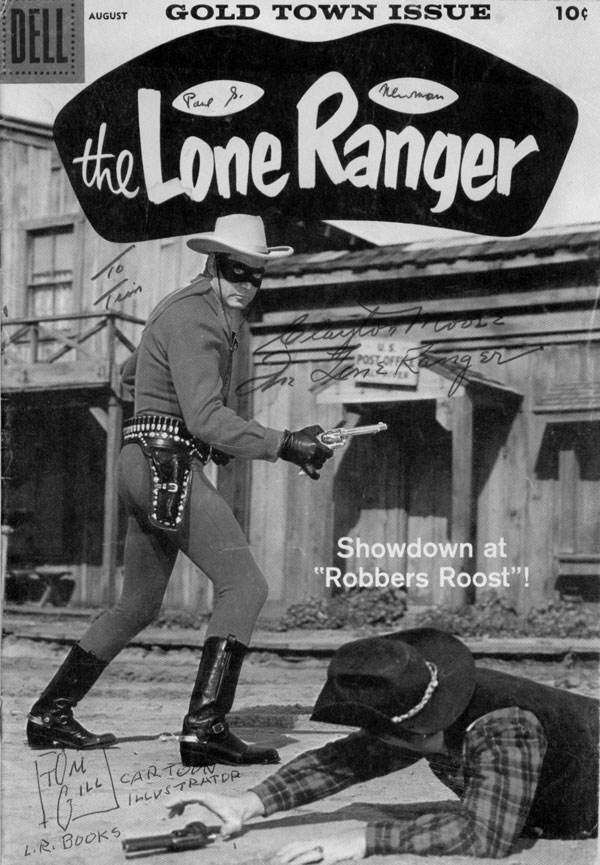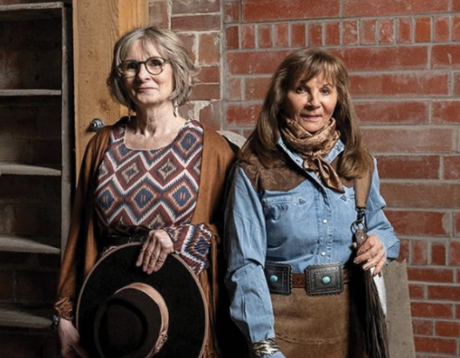
Western Memorabilia in the 21st Century
The hammer fell as the last bid for Clayton Moore’s Lone Ranger costume hit $32,450 at Brian Lebel’s Old West Show and Auction on June 22, 2013 in Denver, Colorado. With that sale, one more iconic Western item would pass from owner to buyer, possibly never to be seen publicly again.
Along with the passing of Hollywood icons, and the growth of sales of Western heritage items, collecting historical artifacts, artwork, and classic TV/movie props has never been so accessible and competitive. Auction houses like Brian Lebel’s Old West Events, Heritage Auctions, Hake’s Auctions, and High Noon Western Americana, Sotheby’s and eBay have transformed the world of collecting.
There have always been numerous types of collectibles and
resources for collectors. In my 2004 book, Collecting Western Memorabilia, I undertook an examination of the breadth and scope of collecting. A scant 10 years later, what was true then, is true no longer.
The largest loss to B-Western canon has been the death of our ‘heroes of yesteryear’. By 1999, Roy Rogers, Clayton Moore, Gene Autry, Bill Boyd, Gabby Hayes, Smiley Burnette, John Wayne, Randolph Scott, and Rex Allen had passed away, leaving a void in the hearts and minds of B-Western film fans. With the passing of John Hart and Monte Hale in 2009, a generation of heroes was nearly completely wiped out.
Fortunately, the 1970s saw various authors and western film fans begin to track down people like Col. Tim McCoy, Roy Rogers, Bill Boyd, William Whitney, Gene Autry, Smiley Burnette, Clayton Moore, Gale Storm, Gail Davis, Jay Silverheels, and so many others, while Hollywood paid tribute to the legends in films like When the West Was Fun, Rustlers Rhapsody and the rise of the Golden Boot Awards in the early 1980s.
Roy Rogers opened up his first of three museums in the mid-1960s and Gene Autry paid homage with the Autry Museum of Western Heritage. Other stars like Rex Allen opened up their own shrines while Tom Mix, Hopalong Cassidy, John Wayne, Will Rogers and William S. Hart were honoured throughout the United States. With the passing of the stars, the Smithsonian and the Autry Museum of Western Heritage began to inherit personal belongings to be preserved for posterity.
With the closure of the Roy Rogers-Dale Evans Museum (version 3) in Branson, Mo., in 2009, the final nail in the coffin had been driven. According to Dusty Rogers, his dad told him that, “If the museum ever started to lose money, to close it down and sell everything.” The resulting auctions created a whirlwind of activity and the dispersal of a lifetime of Roy Rogers’ memories.

For many baby boomers, the sale of Trigger, Buttermilk, and Bullet was the final act of erasing Roy Rogers from the public memory. Many speculated that they would go to the Smithsonian, or the Autry Museum. They did not. In the end, Christies Auction sold the stuffed remains of TVdoms most famous equine for $266,500 to TV Station RFD-TV along with Bullet and Buttermilk.
Buttermilk brought $25,000, Bullet $35,000, Trigger Jr. $18,750 and the famed Bohlin saddle captured $386,500. Later plans to create a Western museum by RFD-TV fell through. The animals remain on display in the foyer ready to ride the range at a single call of “Here Trigger.”
Later years would see Dawn Moore sell items from her father, Clayton’s estate at Sotheby’s and Brian Lebel’s Old West Auction which saw prized Lone Ranger costumes, masks, gun rigs, and boots find new homes. Cowboy star Monte Hale’s estate found its way to the public via eBay earlier this year in a low profile offering.
While the Lone Ranger Stetson hat drew a high bid of $8,260, the Bohlin gun rig fetched $32,450 and the Nudie Suite, boots, and necktie brought in $32,450 in 2013. The prices were beneath what High Noon dropped the hammer on for Moore’s gun and holster set at $47,500 three years earlier.
Just what is the market telling collectors?
I think to answer that question we have to go back and look at two factors that determine the value and collectability of items.
Imagine, if you will, that you are 12 years old and it is 1949. The Lone Ranger and Superman have just premiered on the television set your father bought the family, all eight inches of glorious moving pictures.
At the first strains of Rossini’s masterpiece, you are hooked. With the lilting strains of Happy Trails, you don your Roy Rogers hat, pistols and chaps and settle in. As the sound of Gene Autry belting out Back in the Saddle Again, you are riding Champion across the plains.
What was once ‘fun’ was tossed away, or packed in boxes with comic books and other mass produced goods. If they survived your teenage and college years, they become ‘cool’ and collectible again when you turned 50. Thousands of those Roy Rogers pistols may have survived, and every time you see one, you remember. As the boomer/middle age collector downsizes, massive collections come on market such as the Al Dittrich Lone Ranger storehouse, and what was once a treasure trove is broken up and lost to small collectors, never to be seen again. Prices start high, but once the ‘best’ items are gone, they fall and the profile of the star associated is somehow diminished, as someone has sold their childhood to the highest bidder.

Consider the higher end of Western collectibles.
Since the mid-1800s, Western artists have preserved scenes of native and early cowboy history on canvas, paper, and in bronze, while native cultural items looted from graves or ‘traded’ were preserved in private collections and are now finding themselves on the market.
In terms of native collectibles, the market is stronger in the United States where it is legal to buy and sell native artifacts. Canadian law prohibits the collecting and sale of such items, but items like buffalo and dinosaur bones are still sold, though presumably sourced from non-Canadian sources. A 2014 auction held by Lebel’s Old West Show and Auction for a turn of the century Nez Perce horse mask sold for $40,000 while items like arrowheads dated to 7,500 BCE may sell for a mere $375 or Clovis points dating back 14,000 years BCE range from $1,000 to $2,400.
The collecting of Western artwork is not a ‘common man’ pastime with Charles Russell and Frederic Remington selling for up to $5.6 million. Turn of the century artist N.C. Wyeth has sold for $2.2 million while others artists work ranges from $500 to $1.9 million. Contemporary Western artist James Bama has fetched up to $120,000 for an original, while his giclee’s average $2,000.
When one style of collecting may be considered ‘high brow’ and investments, the other can be practiced by a larger segment of the population and is subject to value fluctuations. A particularly frustrating aspect of buying or selling is that of market conditions and its effect upon long-term pricing and availability or popularity of the character/subject of the item. While price guides do exist for many collectibles and provide a ballpark value, the market ultimately determines the value of any item.
A current example of this might be the Johnny Depp Lone Ranger film released in 2013 that built up expectations for the property, which prompted Dawn Moore to sell her father’s beloved costume in addition to many other collectors releasing their ‘grail’ collectibles. The poor performance of the film led to a devaluation of the property, and consequently of collectibles related to the Lone Ranger.
The value of Western related items, be it entertainment, artwork, or lifestyle related is not only a function of their rarity, or association but rather related to the authenticity and ability to provide provenance. The role of determining authenticity is paramount for any valuation, whether it is for insurance or auction.

Every collector of Western themed items has a different reason for their passion and specialty. They also have different criterion for what they are willing to pay, and how far they are willing to travel. The rise of internet-based auctions and internet bidding allows worldwide bidders while increasing the potential of auction fraud.
The rise of new technologies is another change in collecting. During the early 1960s, B-Western fans started the first fan clubs and sought out 16mm prints of their favourite films. If they were lucky, or lived in California, Col. Tim McCoy might happen by and talk about the movie. With the change from film, to VHS, to DVD, and now digital downloads, a modern collector has no concept of the value and rarity of an original acetate print of “The Adventures of Robin Hood,” now on sale for $19.99 on eBay.
If we look at radio drama, the same situation applies. What was once a one shot opportunity to listen to a “Cavalcade of Stars”, is now a digital download, and if we wish, we can get every episode on streaming MP3!
Other types of collectibles such as movie posters, movie scripts, lunch kits, comic books, books, movie/TV premiums, clothing, coffee mugs, and figurines have waned and can often be found on eBay at less than ‘guide’ prices.
The point is, for some memories and items, the more accessible they are the less we treasure them, and our point of last resort is to sell our childhood memories and family heirlooms. As we move from a rural-based economy, artifacts associated with a lifestyle our grandparents grew up with are often viewed as ‘junk’ and stored away.
One of the most prized possessions in my collection is a triple signed Lone Ranger comic book, and I remember receiving it in the mail like it was yesterday.
I had returned home from work and my wife handed me a package with Clayton Moore, Calabasas on the top left corner. As soon as I saw the name, I grabbed the package and carefully pulled out a copy of Lone Ranger #122, signed by Clayton Moore, To Tim…
For those who have experienced that kind of thrill, it was my grail moment and I will never forget it. Since that time, I have added the signatures of Tom Gill, Lone Ranger comic book artist, and Paul S Neuman, comic book writer. What was once a mere comic book, is now a priceless collectible touched and signed by Lone Ranger luminaries.
Hi Yo Silver, Away!














